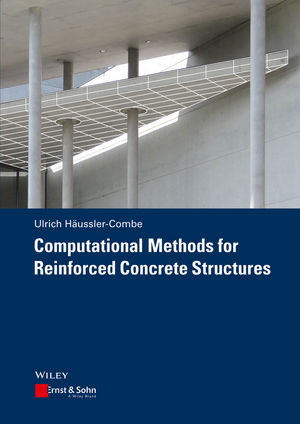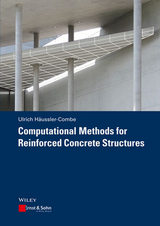Computational Methods for Reinforced Concrete Structures
Wilhelm Ernst & Sohn (Verlag)
978-3-433-03054-7 (ISBN)
- Titel erscheint in neuer Auflage
- Artikel merken
The book covers the application of numerical methods to reinforced concrete structures. To analyze reinforced concrete structures linear elastic theories are inadequate because of cracking, bond and the nonlinear and time dependent behavior of both concrete and reinforcement. These effects have to be considered for a realistic assessment of the behavior of reinforced concrete structures with respect to ultimate limit states and serviceability limit states.
The book gives a compact review of finite element and other numerical methods. The key to these methods is through a proper description of material behavior. Thus, the book summarizes the essential material properties of concrete and reinforcement and their interaction through bond. These basics are applied to different structural types such as bars, beams, strut and tie models, plates, slabs and shells. This includes prestressing of structures, cracking, nonlinear stress-strain relations, creeping, shrinkage and temperature changes.
Appropriate methods are developed for each structural type. Dynamic problems are treated as well as short-term quasi-static problems and long-term transient problems like creep and shrinkage. Most problems are illustrated by examples which are solved by the program package ConFem, based on the freely available Python programming language. The ConFem source code together with the problem data is available under open source rules in combination with this book.
The author aims to demonstrate the potential and the limitations of numerical methods for simulation of reinforced concrete structures, addressing students, teachers, researchers and designing and checking engineers.
Ulrich Häußler-Combe, Prof. Dr.-Ing. habil. studied structural engineering at the Technical University Dortmund and gained his doctorate from the Karlsruhe Institute of Technology (KIT). Following ten years of construction engineering and development in computational engineering, he came back to KIT as a lecturer for computer aided design and structural dynamics. Since 2003 he has been professor of special concrete structures at Dresden University of Technology.
1 FINITE ELEMENT IN A NUTSHELL
Modeling basics
Finite element basics
Elements
Material behavior
Weak equilibrium and discretization
Convergence
Numerical integration and solution methods for algebraic systems
2 UNIAXIAL STRUCTURAL CONCRETE BEHAVIOR
Short-term stress-strain behavior of concrete
Long-term effects ? creep, shrinkage and temperature
Strain-rate effects
Cracks
Reinforcing steel stress?strain behavior
Bond between concrete and reinforcing steel
Reinforced tension bar
Tension stiffening for reinforced tension bar
Cyclic loading of reinforced tension bar
3 2D STRUCTURAL BEAMS AND FRAMES
General cross-sectional behavior
Equilibrium of bars
Structural beam elements in 2D
System building and solution methods
Further aspects
Application case studies
4 STRUT-AND-TIE MODELS
Linear elastic panel solutions
Truss modeling
Computation of plane elasto-plastic truss models
Ideal plastic truss models
Application aspects
5 MULTIAXIAL CONCRETE MATERIAL BEHAVIOR
Scales
Some basics of continuum mechanics
Basic linear material behavior description
Basics of nonlinear material behavior
Isotropic damage
Isotropic plasticity
Long-term bevavior
Short-term behavior
6 DEEP BEAMS
Limit analysis
2D crack modeling
2D modeling of reinforcement and bond
Biaxial concrete material laws
Further aspects and application case studies
7 SLABS
Cross-sectional behavior
Equilibrium of slabs
Structural slab elements
System building and solution methods
Reinforcement design with linear elastic internal forces
APPENDIX
ConFem
Transformations of coordinate systems
Linear regression analysis applications
Numerical integration of elasto-plastic material laws
| Erscheint lt. Verlag | 20.10.2014 |
|---|---|
| Reihe/Serie | CourseSmart |
| Verlagsort | Berlin |
| Sprache | englisch |
| Maße | 170 x 240 mm |
| Gewicht | 705 g |
| Einbandart | Paperback |
| Themenwelt | Mathematik / Informatik ► Mathematik |
| Technik ► Bauwesen | |
| Schlagworte | Baustatik • Betonbau • Spannbeton • Spannbetontragwerk • Stahlbeton • Tragwerk • Tragwerke |
| ISBN-10 | 3-433-03054-5 / 3433030545 |
| ISBN-13 | 978-3-433-03054-7 / 9783433030547 |
| Zustand | Neuware |
| Haben Sie eine Frage zum Produkt? |
aus dem Bereich





